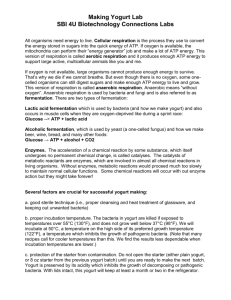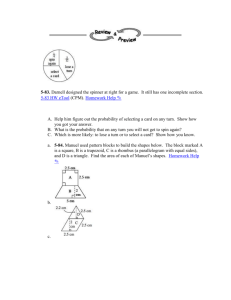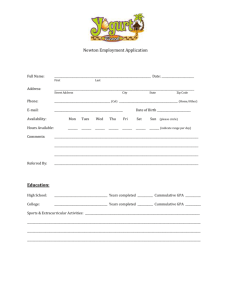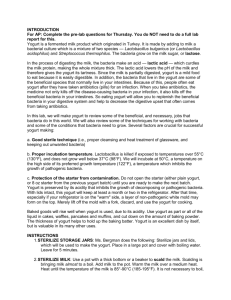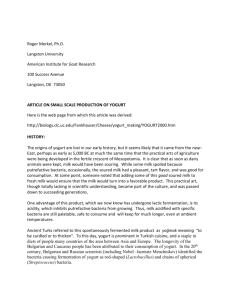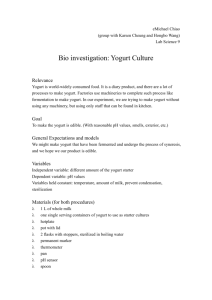Investigating Bacteria Making Yogurt Lab
advertisement
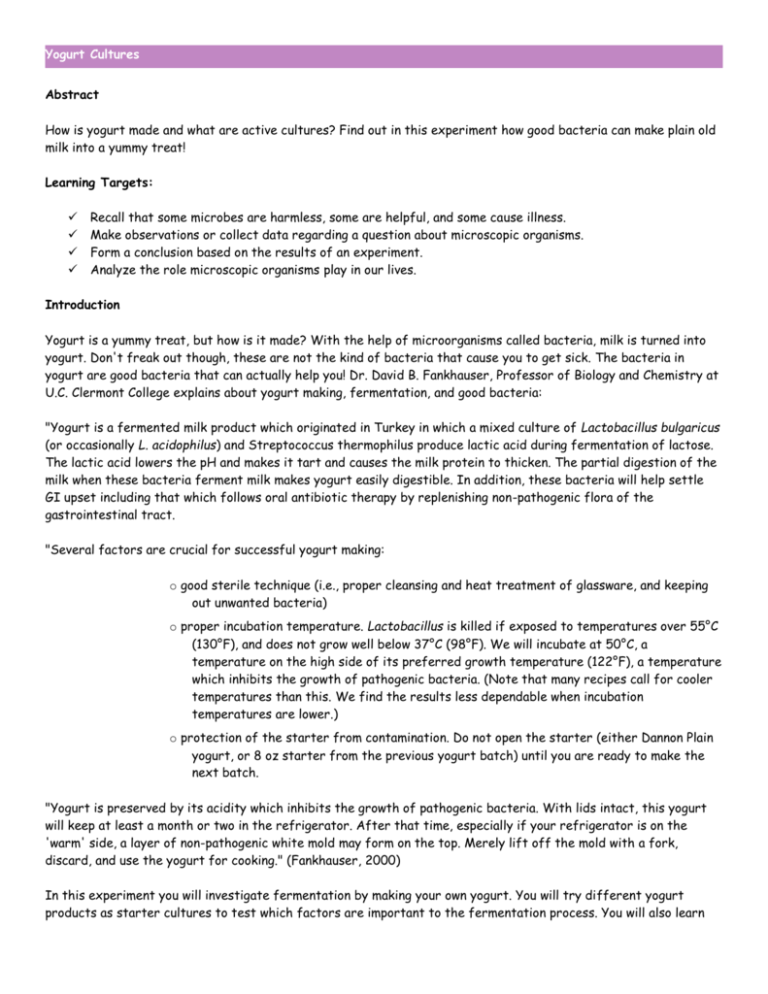
Yogurt Cultures Abstract How is yogurt made and what are active cultures? Find out in this experiment how good bacteria can make plain old milk into a yummy treat! Learning Targets: Recall that some microbes are harmless, some are helpful, and some cause illness. Make observations or collect data regarding a question about microscopic organisms. Form a conclusion based on the results of an experiment. Analyze the role microscopic organisms play in our lives. Introduction Yogurt is a yummy treat, but how is it made? With the help of microorganisms called bacteria, milk is turned into yogurt. Don't freak out though, these are not the kind of bacteria that cause you to get sick. The bacteria in yogurt are good bacteria that can actually help you! Dr. David B. Fankhauser, Professor of Biology and Chemistry at U.C. Clermont College explains about yogurt making, fermentation, and good bacteria: "Yogurt is a fermented milk product which originated in Turkey in which a mixed culture of Lactobacillus bulgaricus (or occasionally L. acidophilus) and Streptococcus thermophilus produce lactic acid during fermentation of lactose. The lactic acid lowers the pH and makes it tart and causes the milk protein to thicken. The partial digestion of the milk when these bacteria ferment milk makes yogurt easily digestible. In addition, these bacteria will help settle GI upset including that which follows oral antibiotic therapy by replenishing non-pathogenic flora of the gastrointestinal tract. "Several factors are crucial for successful yogurt making: o good sterile technique (i.e., proper cleansing and heat treatment of glassware, and keeping out unwanted bacteria) o proper incubation temperature. Lactobacillus is killed if exposed to temperatures over 55°C (130°F), and does not grow well below 37°C (98°F). We will incubate at 50°C, a temperature on the high side of its preferred growth temperature (122°F), a temperature which inhibits the growth of pathogenic bacteria. (Note that many recipes call for cooler temperatures than this. We find the results less dependable when incubation temperatures are lower.) o protection of the starter from contamination. Do not open the starter (either Dannon Plain yogurt, or 8 oz starter from the previous yogurt batch) until you are ready to make the next batch. "Yogurt is preserved by its acidity which inhibits the growth of pathogenic bacteria. With lids intact, this yogurt will keep at least a month or two in the refrigerator. After that time, especially if your refrigerator is on the 'warm' side, a layer of non-pathogenic white mold may form on the top. Merely lift off the mold with a fork, discard, and use the yogurt for cooking." (Fankhauser, 2000) In this experiment you will investigate fermentation by making your own yogurt. You will try different yogurt products as starter cultures to test which factors are important to the fermentation process. You will also learn how to culture (grow) microorganisms, and how to use sterile techniques so that you won't contaminate your cultures. Terms, Concepts and Questions to Start Background Research To do this type of experiment you should know what the following terms mean. Have an adult help you search the internet, or take you to your local library to find out more! yogurt microorganism bacteria fermentation culture Questions How is yogurt made? Do the cultures need to be live and active? Do you need pasteurized or unpasteurized yogurt as a starter culture? Materials and Equipment 1 gallon of whole milk different brands of single serving containers of yogurt to use as starter cultures. Try using several different types of products for comparison, here are some ideas: o products with live and/or active cultures o products that are heat pasteurized and do not contain live or active cultures o products that have flavoring or coloring agents added o products with added stabilizers, such as gelatin large double boiler (or heavy pot) with lid several 8 oz canning jars with lids, sterilized in boiling water permanent marker candy thermometer with a range of 40 to 90oC (100 to 200oF) 1 styrofoam cooler Experimental Procedure 1. Heat the milk to 85–90oC (185–195oF) in a double boiler, keeping the pot covered to reduce evaporation. You can also use a heavy-bottomed pot, but stir frequently to prevent the milk from sticking to the bottom. 2. Remove from stove and place the covered pot in a pan of clean, cool water until the stirred milk is very close to 55oC (130oF). 3. While the milk is cooling, prepare your yogurt starters. 4. Arrange several pre-sterilized canning jars (one for each starter) and loosen the lids. 5. Open each yogurt product you will use as a starter and stir with a clean fork to be sure it is mixed evenly. 6. Add one tablespoon of each starter to each jar. Label the jar with the brand name using a permanent marker. 7. After the milk cools to 55oC (130oF), it will still be warm to the touch. Carefully pour it into the canning jars filling the jars almost full, with about 1/2 inch from the top. Cover immediately with the sterile lids. 8. Place filled bottles in cooler, add enough 50oC (122oF) water so that bottles are surrounded, but the water is well below the lid rims. 9. Do not disturb the yogurt and it will be finished in 3 hours, provided the temperature does not drop below 40oC (104oF). Refrigerate overnight. 10. The next day open and examine each yogurt. Did the product gel? Is it firm or runny? Does it smell good or bad? 11. Write your observations in a data table: Brand Name Does it have active cultures? (Y/N) Did it gel? (Y/N) Observations of smell, taste, color, etc. 12. Evaluate your results. Which starter makes the best yogurt? Should you use pasteurized or unpasteurized? What happens if your starter does not have active cultures? Variations You can also test the effects of flavorings on yogurt cultures. Will flavored yogurt work as a starter culture? What about preservatives? Does organic yogurt work better than regular? You can test if the amount of starter used in the culture makes a better product. Is it better to use more or less? Does it take a longer or shorter time? You can test which kind of milk works best. Try using whole, 2%, and skim milk. Also try using alternative products to cows milk: can you use goat milk, Lactaid, or soy milk? Credits Sara Agee, Ph.D., Science Buddies Last edit date: 2007-02-13 11:30:00


